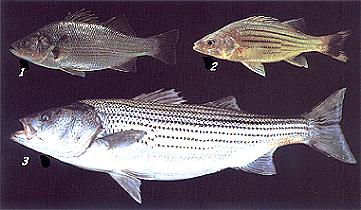Few gamefish provide as much angling excitement as
white bass. The silvery fish cruise about in schools that
may cover several acres. Fishermen who find these huge
schools often enjoy spectacular fishing.

Orginally found in the Great Lakes, St. Lawerence River and
the Missippi River system, white bass have been successfully stocked
in many other regions, particularly the Southeast and Southwest.
Commonly introduced in new reservoirs, they provide excellent
fishing two to three years after stocking.
White bass thrive in lakes and reservoirs connected to
large river systems. They prefer relatively clear water with
gravel, sand or rock bottoms. But they also live in murky
waters. Unlike sunfish and crappies, white bass rarely seek
cover. Instead, they spend most of their time in open water
from 10 to 30 feet deep.
A member of the temperate bass family,
the white bass has several close relatives including the white
perch, yellow bass and the striped bass. In the 1960s, fisheries
biologists first crossed male white bass with female striped bass to
produce an aggressive, extremely fast-growing hybrid. These fish
are being stocked in many warmwater resevoirs throughout the
South.

Close relatives of the white bass include (1) white perch, which
lack lack the horizontal stripes of other temperate bass; (2) yellow bass,
which resemble white bass in body shape but have dorsal fins joined
slightly at the base; (3) striped bass, which have a slimmer body and
distinct, unbroken stripes below the lateral line.
Often called sand bass, striper or silver bass, the
white bass has silvery sides laced with rows of dark lines. Its
belly is white, but the back may vary from bluish-gray to dark
green.
White bass rely primarily on eyesight for chasing and catching
their prey. In most waters, they feed almost exclusively on small
shad, when they are available. They also eat emerald shinners and
other small fish, in addition to crayfish, mollusks, worms and insects.
White bass gorge themselves on mayflies during a hatch.
In waters with large populations of shad, white bass grow
quickly. In warm, southern reservoirs, a fish may reach 1 pound
after just two years. But white bass to not attain large sizes, because
they seldom live longer than six years.
Most white bass caught by angling weigh between 1and 2
pounds. The world record, taken from Lake Orange, Virginia, in
1989, weighed 6 pounds, 13 ounces.
White bass spawn in tributary streams of large lakes and
reservoirs, typically in water 58 to 64 degrees F. They do not
build nests. The female deposits her eggs in the current, while
the male releases his sperm, fertilizing the eggs as they sink.
The eggs stick to gravel, rocks or vegetation where they normally
hatch within 24 to 48 hours. A female may deposit more than a
half-million eggs.
Spawning activity usually last five to ten days. Parents do not
guard the eggs, but begin migrating back to the lake.
After hatching, the tiny fry form dense schools, a
characteristic that white bass exhibit all of ther lives. The
schools move about constantly, some roaming as much as
seven miles a day. Tagged white bass have been found over
100 miles away from where they were marked.
Where to Find White Bass Next Time!
|


